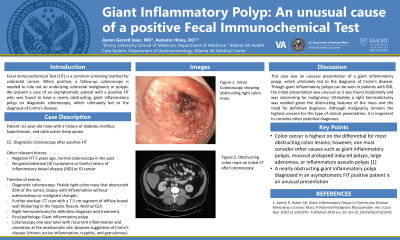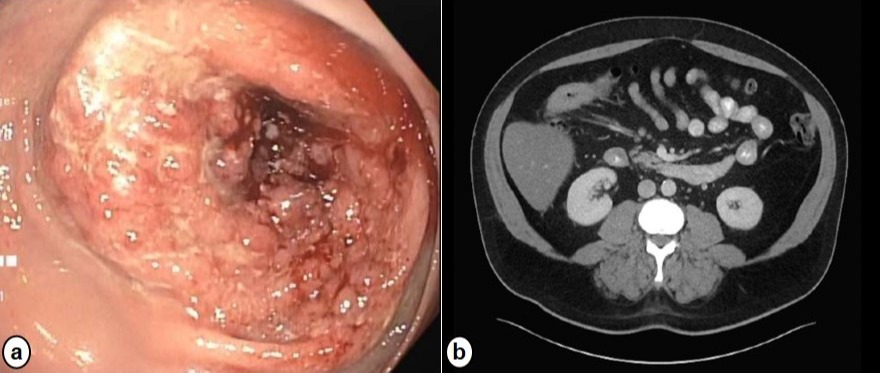Back


Poster Session B - Monday Morning
Category: Colon
B0149 - Giant Inflammatory Polyp: An Unusual Cause of a Positive Fecal Immunochemical Test
Monday, October 24, 2022
10:00 AM – 12:00 PM ET
Location: Crown Ballroom

Has Audio

Aaron Issac, MD
Emory University School of Medicine
Atlanta, GA
Presenting Author(s)
Aaron Issac, MD1, Autumn Hines, DO2
1Emory University School of Medicine, Atlanta, GA; 2Emory University School of Medicine, Atlanta, Guam
Introduction: Fecal Immunochemical test (FIT) is a common screening method for colorectal cancer. When positive, a follow-up colonoscopy is needed to rule out an underlying colorectal malignancy or polyps. We present a case of an asymptomatic patient with a positive FIT who was found to have a nearly obstructing, giant inflammatory polyp on diagnostic colonoscopy, which ultimately led to the diagnosis of Crohn’s disease.
Case Description/Methods: A 61-year-old male with a history of diabetes mellitus, hypertension, and obstructive sleep apnea presented for a diagnostic colonoscopy after being found to have a positive FIT as part of his annual physical. Prior to this the patient had a negative FIT 5 years ago and a normal colonoscopy in the distant past. He reported no abdominal discomfort, rectal bleeding, change in bowel habits, family history of inflammatory bowel disease (IBD) or colorectal cancer, and used NSAIDs only as needed. During his diagnostic colonoscopy, he was found to have a friable right colon mass that took up 85% of the lumen. The scope could not traverse the mass. On histology, the mass showed inflammation without adenomatous or malignant changes. A subsequent CT scan was performed that showed a 7.5 cm segment of diffuse bowel wall thickening compromising the lumen in the hepatic flexure. Given the features of the nearly obstructing mass, it was decided that the patient was a candidate for a right hemicolectomy for definitive diagnosis and treatment. On final pathology, findings were consistent with a giant inflammatory polyp. A colonoscopy performed one year later showed recurrent inflammation and ulceration at the anastomotic site, in addition to inflammation in the transverse colon. Biopsies of this area revealed findings suggestive of Crohn’s disease (chronic active inflammation, cryptitis, and granulomas).
Discussion: This case was an unusual presentation of a giant inflammatory polyp, which ultimately led to the diagnosis of Crohn’s disease. Though giant inflammatory polyps can be seen in patients with IBD, the initial presentation was unusual as it was found incidentally and was concerning for malignancy. Ultimately a right hemicolectomy was needed given the obstructing features of the mass and the need for definitive diagnosis. Although malignancy remains the highest concern for this type of clinical presentation, it is important to consider other potential diagnoses.

Disclosures:
Aaron Issac, MD1, Autumn Hines, DO2. B0149 - Giant Inflammatory Polyp: An Unusual Cause of a Positive Fecal Immunochemical Test, ACG 2022 Annual Scientific Meeting Abstracts. Charlotte, NC: American College of Gastroenterology.
1Emory University School of Medicine, Atlanta, GA; 2Emory University School of Medicine, Atlanta, Guam
Introduction: Fecal Immunochemical test (FIT) is a common screening method for colorectal cancer. When positive, a follow-up colonoscopy is needed to rule out an underlying colorectal malignancy or polyps. We present a case of an asymptomatic patient with a positive FIT who was found to have a nearly obstructing, giant inflammatory polyp on diagnostic colonoscopy, which ultimately led to the diagnosis of Crohn’s disease.
Case Description/Methods: A 61-year-old male with a history of diabetes mellitus, hypertension, and obstructive sleep apnea presented for a diagnostic colonoscopy after being found to have a positive FIT as part of his annual physical. Prior to this the patient had a negative FIT 5 years ago and a normal colonoscopy in the distant past. He reported no abdominal discomfort, rectal bleeding, change in bowel habits, family history of inflammatory bowel disease (IBD) or colorectal cancer, and used NSAIDs only as needed. During his diagnostic colonoscopy, he was found to have a friable right colon mass that took up 85% of the lumen. The scope could not traverse the mass. On histology, the mass showed inflammation without adenomatous or malignant changes. A subsequent CT scan was performed that showed a 7.5 cm segment of diffuse bowel wall thickening compromising the lumen in the hepatic flexure. Given the features of the nearly obstructing mass, it was decided that the patient was a candidate for a right hemicolectomy for definitive diagnosis and treatment. On final pathology, findings were consistent with a giant inflammatory polyp. A colonoscopy performed one year later showed recurrent inflammation and ulceration at the anastomotic site, in addition to inflammation in the transverse colon. Biopsies of this area revealed findings suggestive of Crohn’s disease (chronic active inflammation, cryptitis, and granulomas).
Discussion: This case was an unusual presentation of a giant inflammatory polyp, which ultimately led to the diagnosis of Crohn’s disease. Though giant inflammatory polyps can be seen in patients with IBD, the initial presentation was unusual as it was found incidentally and was concerning for malignancy. Ultimately a right hemicolectomy was needed given the obstructing features of the mass and the need for definitive diagnosis. Although malignancy remains the highest concern for this type of clinical presentation, it is important to consider other potential diagnoses.

Figure: Figure 1 (a) Obstructing right colon mass seen on initial colonoscopy (b) Surveillance CT after initial colonoscopy showing obstructing colon mass.
Disclosures:
Aaron Issac indicated no relevant financial relationships.
Autumn Hines indicated no relevant financial relationships.
Aaron Issac, MD1, Autumn Hines, DO2. B0149 - Giant Inflammatory Polyp: An Unusual Cause of a Positive Fecal Immunochemical Test, ACG 2022 Annual Scientific Meeting Abstracts. Charlotte, NC: American College of Gastroenterology.
